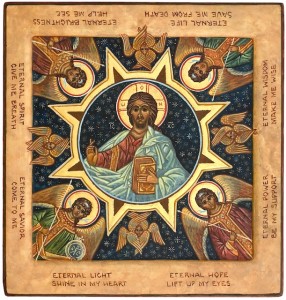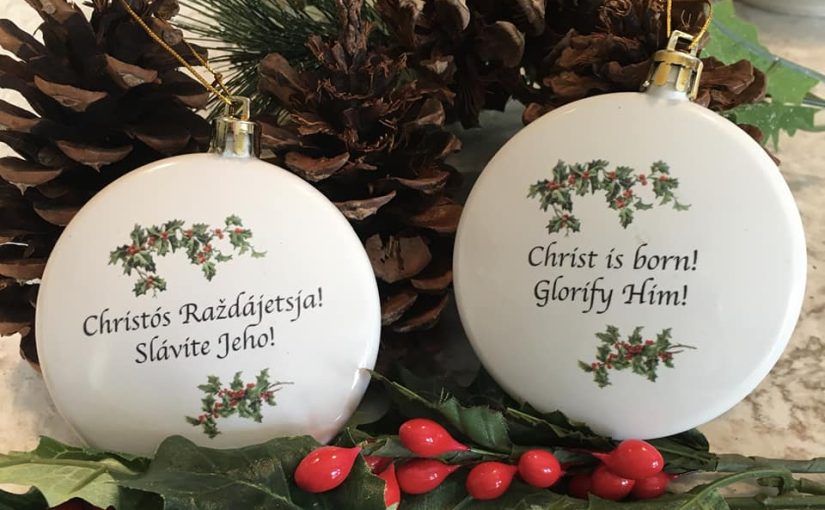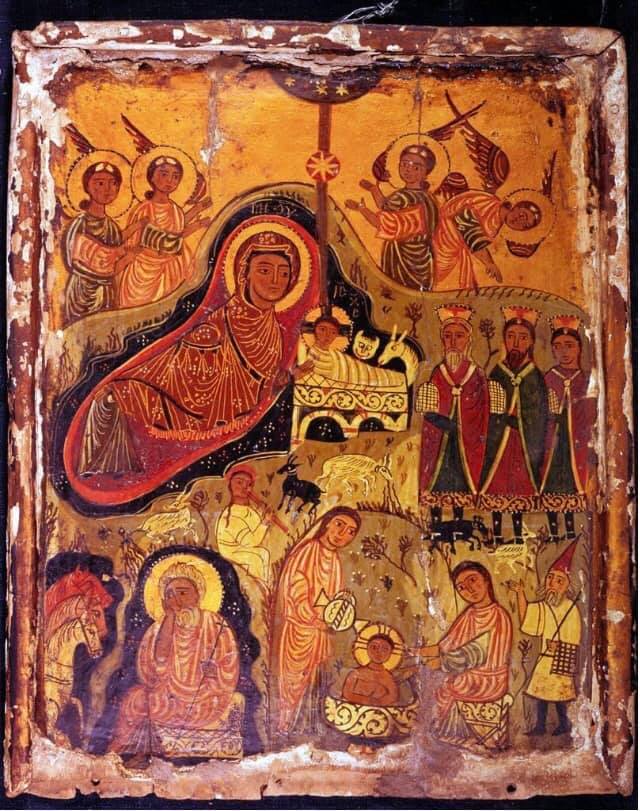“For God so loved the world that he gave his one and only Son, that whoever believes in him shall not perish but have eternal life.” Jn. 3:16
Tag: Nativity of the Lord
Living on the edge of eternity
The following reflection was written for members of the Order of the Holy Sepulchre of Jerusalem and published on one of the Facebook groups of the Order.
In a week’s time we will be celebrating the Nativity of our Lord and Savior, Jesus Christ. A fact. An experience of Faith. The Fathers of the Church teach us that the Incarnation means that God Who is incomprehensible and inexpressible lowered Himself in His mercy taking human nature to not only restore what Adam lost, but to offer us the possibility of our participation in His divine nature. This participation is what we call theosis.
Here is something for us to think about as we prepare for the Nativity of the Lord. There’s a Divine promise contained in the event of the Incarnation. The following homily for Advent delieverd by St. Bernard of Clairvaux (1090-1153) notes for us the contours of the promise.
“We know that there are three comings of the Lord. The third lies between the other two. It is invisible, while the other two are visible.“In the first coming he was seen on earth, dwelling among men; he himself testifies that they saw him and hated him. In the final coming all flesh will see the salvation of our God, and they will look on him whom they pierced. The intermediate coming is a hidden one; in it only the elect see the Lord within their own selves, and they are saved. In his first coming our Lord came in our flesh and in our weakness; in this middle coming he comes in spirit and in power; in the final coming he will be seen in glory and majesty.
“In case someone should think that what we say about this middle coming is sheer invention, listen to what our Lord himself says: If anyone loves me, he will keep my word, and my Father will love him, and we will come to him [Jn. 14:23].
“There is another passage of Scripture which reads: He who fears God will do good, but something further has been said about the one who loves, that is, that he will keep God’s word. Where is God’s word to be kept? Obviously in the heart, as the prophet says: I have hidden your words in my heart, so that I may not sin against you.
“Keep God’s word in this way. Let it enter into your very being, let it take possession of your desires and your whole way of life. Feed on goodness, and your soul will delight in its richness. Remember to eat your bread, or your heart will wither away. Fill your soul with richness and strength.
“Because this coming lies between the other two, it is like a road on which we travel from the first coming to the last. In the first, Christ was our redemption; in the last, he will appear as our life; in this middle coming, he is our rest and consolation.
“If you keep the word of God in this way, it will also keep you. The Son with the Father will come to you. The great Prophet who will build the new Jerusalem will come, the one who makes all things new. This coming will fulfill what is written: As we have borne the likeness of the earthly man, we shall also bear the likeness of the heavenly man. Just as Adam’s sin spread through all mankind and took hold of all, so Christ, who created and redeemed all, will glorify all, once he takes possession of all” (Office of Readings, Wednesday, First week of Advent).
St. Bernard’s theological reflection can be said as follows:
~First Coming – Jesus’ birth at Bethlehem;
~Second Coming – Spiritual coming of the Lord to each believer, sacramentally;
~Third Coming – Jesus coming again at the end of the world.
In what ways does what St. Bernard impact our our lives as members of the Order of the Holy Sepulchre? Hopefully, it re-orients how we live the reality of our sacramental life, and to give good witness to the Good News. As Knights and Dames of Holy Sepulchre we may want to consider what we are looking forward to on December 25th and in the Octave that follows.
Advent is a time of waiting for the Messiah: we wait for God to come into our lives, in reality. Christmas teaches us that sentimentality isn’t the goal, but the Infinite God is. The Word made flesh, the Incarnation, is the center of time and energy today.
However busy or distracted you might be in the coming days before Christmas, take note of what St. Bernard says about the coming of the Messiah, and the think about promise it contains for us. It is not merely a theological reflection, it is an experience.
Take courage, live in peace.
Artwork: The Nativity by Marco Foppoli, a heraldic artist and illustrator living and working in Brescia, Italy.
The Candle
A Blessed Christmas feast to you and your family. I ended up going to the midnight Mass at the local monastery of Dominican nuns to help with a potential problem of crowds given a C19 crisis at the Catholic parish whose pastor was exposed. Luckily, the crowd was small. Protecting the nuns is of the utmost concern. Since I am in bed nightly at 9:30 I have a renewed appreciation for those who make the sacrifice to spend it in watching –in vigil– with the Lord. So much of the important biblical narratives happens at night thus making the night solemn, holy, peaceful, set-apart. Keeping vigil with the Holy Family refocusses me on the desire to be with the Lord as he gives witness through His Life-giving Incarnation for the life of the world.
On Christmas Day I assisted at my Melkite parish of St Ann (Waterford). The emphasis of the Christmas troparia (the hymns) was not only on the Nativity in the Flesh of our Lord and God and Savior Jesus Christ,
“Today the Virgin gives birth to the Transcendent One, and the earth offers a cave to the Unapproachable One! Angels, with shepherds, glorify Him! The wise men journey with a star! Since for our sake the Eternal God is born as a little child” (Kontakion).
BUT also to reframe the pagan (unbelieving) crowd who hold to secular and folks tales as true offering them the possibility of salvation with, in and through Jesus Christ –the True Sun of Righteousness (Malachi 4). The false beliefs of the pagans of 2000 years ago are the same today: the rejection of the revelation of the One, Triune God in Jesus’ becoming flesh for our redemption. There is a polemic established in the Church’s troparion because it puts aside pagan worship and gives truth and adored. The Church sings,
“Your Nativity, O Christ our God, has shone to the world the light of wisdom! For by it, those who worshipped the stars were taught by a star to adore You, the Sun of Righteousness and to know You, the Orient from on high (LK 1:78 also translated as Dawn or Dayspring). O Lord, glory to You!”
The pulsating heart and mind comes to accept and confess that at Christmas we know and love and adore Son of God became man so that man might become divine, sons and daughters of God the Father by the indwelling of the Holy Spirit.
Father Alexander Men (1935-90) was martyred for the Christian Faith by the Soviets. Men is a compelling preaching in part because of heritage a convert from Judaism to the Orthodox Church. My friend Bishop Seraphim Joseph Sigrist posted this poem about Men by Alexander Zorin, “The Candle”. Zorin helps us better understand the mystery we are observing today using the Father Alexander’s a mirror to Jesus the New Light.
The Candle
(A Poem about Fr. Alexander Men)
“He came out to guide us to the gate,
but then became our escort through the forest.
Black on black
the night stood like a wall, close in.
On a rolled-out, starry scroll
super-worldly letters twinkled.
His candle cast its light
and from the darkness–sheds, a brick-pile,
footbridges, ditches, a muddy road
spiraling beyond our comprehension,
leading on through time and ages.
He joked: from here on out this star here
will guide you. Follow it gracefully.
And since it seems no one else here below
will light the way, he raised his candle high.”
Translated by Richard Dauenhauer
(third working draft, Advent 2007)
Shortness of days give testimony to someone Greater
 The solemn feast of the Son coheres with with the shortness of the cosmic days. Just yesterday we observed the first day of the winter solstice and also the Advent Ember Day. You might say that heaven and earth, the immaterial and material coalesce to point to something richer than any human thought can conceive.
The solemn feast of the Son coheres with with the shortness of the cosmic days. Just yesterday we observed the first day of the winter solstice and also the Advent Ember Day. You might say that heaven and earth, the immaterial and material coalesce to point to something richer than any human thought can conceive.
The saints have something to say to us as a locus theologicus: concrete experience of the Incarnate Son of God leads to new ways of conceiving human existence. The saint bears witness to his or her Creator, the Savior of the world and therefore holds up for us a new and deeper way to understand the Divine Mystery.
One only has to meditate on the O Antiphons sung at the time of the Magnificat at Vespers to have a sense of divine action in history. But let’s return to a saint who makes a good connection with what you see out your window and what is placed in the heart, that is, who is given to us by the Almighty.
Saint Maximus of Turin: “Even if I were to keep silence, my friends, the season would warn us that the birthday of Christ our Lord is at hand. The year is coming to an end and forestalls the subject of my sermon. The depressing shortness of the days itself testifies to the imminence of some event which will bring about the betterment of a world urgently longing for a brighter sun to dispel its darkness. In spite of fearing that its course may be terminated within a few brief hours, the world still shows signs of hope that its yearly cycle will once more be renewed. And if creation feels this hope, it persuades us also to hope that Christ will come like a new sunrise to shed light on the darkness of our sins, and that the Sun of Justice, in the vigor of his new birth, will dispel the long night of guilt from our hearts. Rather than allow the course of our life to come to an end with such appalling brevity, we are confident that he will extend it by his powerful grace.”
Thanks is due to St Francis of Assisi for the Nativity Scene
Just prior to Christmas Pope Benedict XVI reflected on
Saint Francis of Assisi’s gift to the Church in 1223 of the Nativity scene.
Then, as now we see Humility, Jesus, encountering the nihilism of the world, a
people who entranced with violence and anger now faced with the Prince of
Peace, the true king of the universe.
nativity, the defenseless love of God was shown, his humility and goodness,
which in the incarnation of the Word is manifested to man so as to teach a new
way to live and to love. He saw a little child lying still in a manger; the
child woke up because Francis approached… ‘This vision was not different than
real life, since through the work of his grace acting by way of his holy
servant Francis, the Child Jesus was resurrected in the hearts of many. Thanks
to St. Francis, the Christian people have been able to perceive that at
Christmas, God truly has become Emmanuel, God-with-us, from whom no barrier or
distance can separate us. In this Child, God has come so near to each one of
us, so close, that we can address him with confidence and maintain with him a
trusting relationship of deep affection, as we do with a newborn. In this
Child, in fact, God-Love is manifested: God comes without weapons, without
strength, because he does not aim to conquer, we could say, from without, but
rather wants to be welcomed by man in liberty. God becomes a defenseless Child to
conquer man’s pride, violence and desire to possess. In Jesus, God took up this
poor and defenseless condition to conquer with love and lead us to our true
identity … so that he concedes to our hearts this simplicity that recognizes
the Lord in this Child, precisely as Francis did in Greccio. Then, we too can
experience what […] happened to those present […] ‘Each one returned to his
house filled with an ineffable joy.
Nativity
 Immensity cloistered in thy dear womb, Now leaves His well-belov’d imprisonment, There He hath made Himself to His intent Weak enough, now into the world to come; But O, for thee, for Him, hath the inn no room? Yet lay Him in this stall, and from the Orient, Stars and wise men will travel to prevent; The effect of Herod’s jealous general doom.
Immensity cloistered in thy dear womb, Now leaves His well-belov’d imprisonment, There He hath made Himself to His intent Weak enough, now into the world to come; But O, for thee, for Him, hath the inn no room? Yet lay Him in this stall, and from the Orient, Stars and wise men will travel to prevent; The effect of Herod’s jealous general doom.
Seest thou, my soul, with thy faith’s eyes, how He which fills all place, yet none holds Him, doth lie? Was not His pity towards thee wondrous high, That would have need to be pitied by thee?
Kiss Him, and with Him into Egypt go, With His kind mother, who partakes thy woe.
John Donne (1572- 1631)



